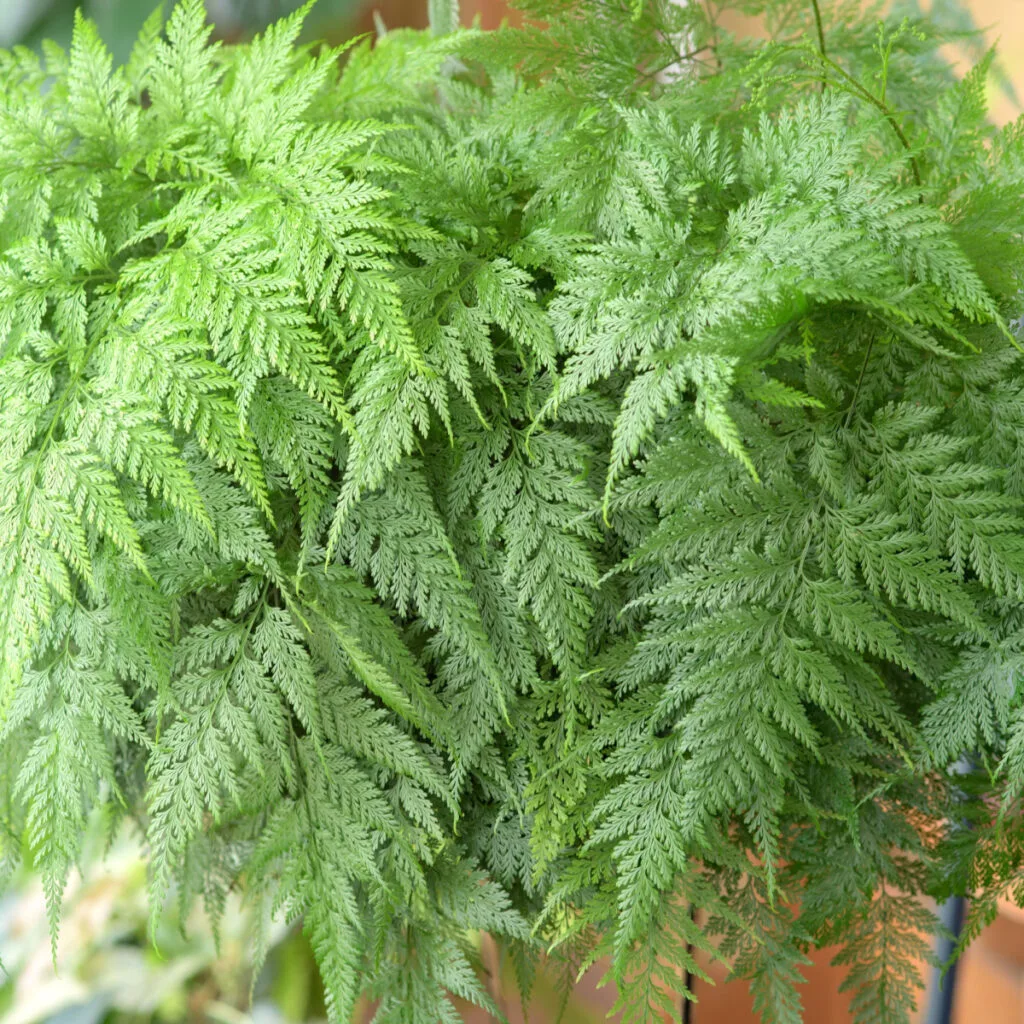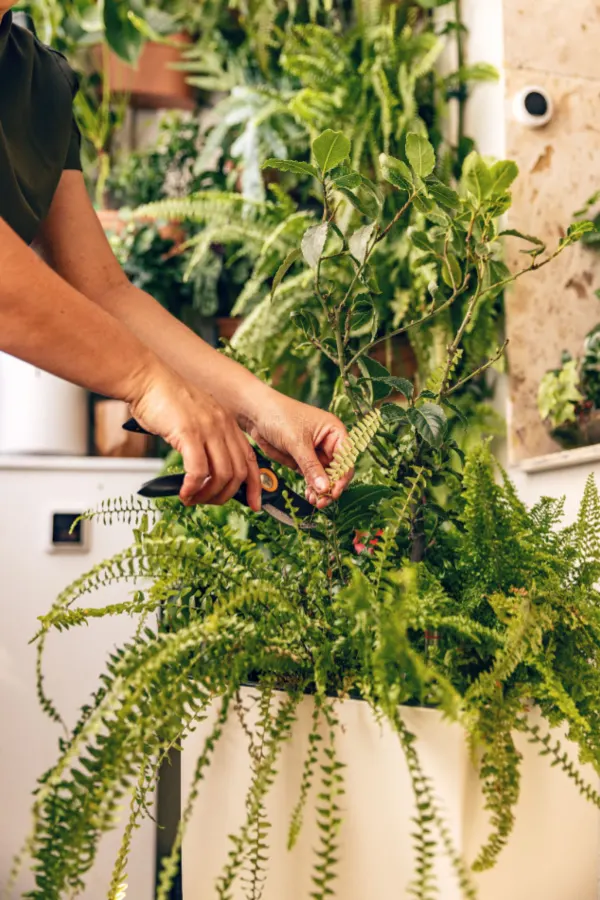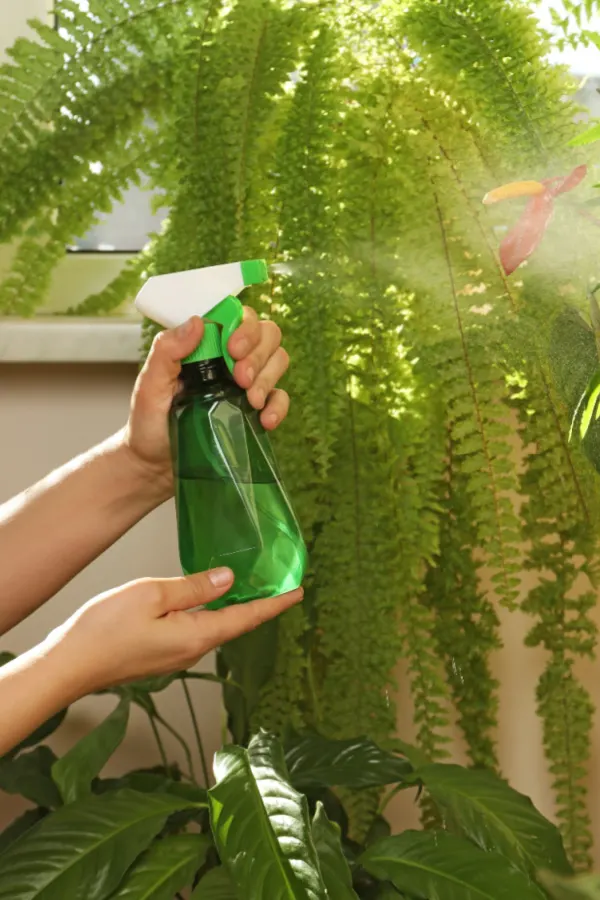Did you know you could move the gorgeous ferns you have growing outdoors to the indoors this fall to grow as a beautiful houseplant all winter long?
One of the best ways to brighten up the inside of your home in the winter is with houseplants. Not only do they add color and interest indoors, they also help to keep the air from being overly dry. In fact, houseplants release over 90% of the water they take in back into the air, helping to keep humidity levels up inside – at a time when furnaces, heaters and wood stoves can all but make it disappear.
One thing is for sure, a few houseplants indoors can definitely help keep your skin from drying out in the winter – especially when those plants can include some of the big ferns you had growing outside in the summer!

Ferns are one of the most popular container plants of all for growing outdoors. The shade loving plants are perfect for adding big beauty to porches, patios, or anywhere the sun doesn’t drench with direct sunlight.
But those same features actually make it perfect for saving and growing inside in the winter. And by simply bringing your plants in, not only can you add life and a little humidity, you can also save on having to repurchase next spring!
With all of those benefits in mind, here is an in-depth look at how to save and grow ferns over the winter as a houseplant!
How To Grow Ferns Indoors – 3 Simple Secrets To Success
When bringing fern indoors for the winter, there are three key needs that need to be met for success. First and foremost, ferns have to receive adequate lighting to maintain vibrant and strong. If there is not enough light, it will quickly cause browning off and leaf loss.
Secondly, they also need to get the right amount and kind of moisture. Too much moisture, and their roots will become soggy and rot out. And without enough? Again the plant can brown off, lose a large majority of its leaves and even die out.

Last but not least, indoor ferns also need to be kept at the perfect temperature to grow and flourish. As you’ll see below, that not only includes the room temperature, but also keeping ferns clear of drafts and heat sources.
But before we get to the specific requirements of those three critical factors, it’s first important to know how to and when to bring your outdoor ferns indoors in the fall.
When & How To Bring Ferns Inside – How To Grow Ferns Indoors
Ferns are extremely susceptible to frost and freeze. If left outdoors too late in the season, a heavy frost or freeze will injure or kill plants in a flash. Because of that, you will want to bring ferns inside long before the risk of cold can put it in jeopardy.
Before moving inside, you should always first spray your ferns off with water. Not only will this help hydrate them a bit, it will also help dislodge any insects trying to hitch a ride indoors.
Using a garden hose and spray nozzle, spray the plant thoroughly. Be sure to lift the undersides of the fronds up as well and spray. Next, remove any dead or dying fronds from the plant. All that is left is to allow the plant to dry – and find a great location to overwinter it inside!

Light, Water & Temperature
Proper Lighting For Ferns – How To Grow Ferns Indoors
To perform at their best, ferns need to receive filtered light and not direct sunlight. Remember that outdoors, ferns cannot handle the hot sun directly. And the same goes for them inside as well.
Ferns like to grow in rooms that get natural light from windows, but not direct sunlight. For this reason, you never want to place a fern right up next to a window. Instead, place it back five to ten feet from windows so it only receives indirect sunlight.
Unfortunately, placing it right up to the glass will not only give it too much light, it can even burn the foliage! The one exception here is when hanging a fern at the top of a window. Up high, it won’t receive direct rays from the sun – but instead more ambient sunlight.
Providing The Right Moisture – How To Grow Ferns Indoors
When it comes to watering ferns indoors, less is more. Indoors, ferns like the soil to be moist, but never wet. Overwatering ferns can saturate the roots. In mild cases, it can brown the leaves and cause many to fall to the ground. However, if severe enough, it can kill the plant entirely.

As a general rule of thumb, most indoor ferns will need to be watered weekly. This will allow the soil around the roots to stay moist and just begin to slightly dry out.
One of the easiest ways to tell the moisture level in the soil is with an inexpensive soil meter probe. By simply sticking the probe in the soil, you get an instant reading of the moisture level below. These meters are actually great for all kinds of container and hanging basket plants! Affiliate Link: Soil Moisture Meter
One more note on watering – misting plants every few weeks can also do wonders to keep foliage healthy and strong. Ferns can absorb moisture through their fronds, and indoors, it can help keep them hydrated without constantly watering the soil. It’s a great way to keep fern’s fronds bright and green!
All you need to do is fill a handheld spray water bottle with tap or purified water and lightly mist. Avoid using treated or softened water as the chemicals in the water can damage the plant’s leaves.
Temperature – How To Grow Ferns Indoors
Ferns do not like excessively hot or cold temperatures. Because of that, placing your ferns in a room with an ambient air temperature between 60° and 70° (F) is ideal for strong, winter growth.

Just as important if not more critical is to keep your indoor ferns in the winter out of drafts and excessive heating or cooling sources. Place them away from heating and cooling vents and cool air ducts. In addition, do not locate them near stoves, heaters or anywhere strong drafts can hit them.
One final note on bringing ferns inside – if your fern has been growing for a few years or grew exceptionally large over the summer – you may want to divide it before winter. This is actually an easy process and can leave you with even more ferns indoors – and to grow outdoors next year as well! (See: How To Divide Ferns In The Fall)
Here is to growing your ferns inside this winter as houseplants!
Follow Our Facebook Page For Even More Great Tips! Simple Garden Life Facebook Page
Simple Garden Life is a website dedicated to keeping gardening fun, simple and enjoyable! We publish two new articles each week along with a new garden podcast episode every two weeks. This article may contain affiliate links.
